
Atlas F1 Technical Writer
The Canadian Grand Prix is one of the toughest races of the year, with the brakes and the engines being constantly put to the test. This year's race was no different. Craig Scarborough reviews the cars and their performance in the eighth round of the 2002 season
Race strategy for Canada has long been thought as a one stopper and the longer you can stay out the better. This year, two stop strategies were on the cards and although riskier could well have paid off. In the race several leading teams decided to split the strategies of their drivers in order to play a team game and minimise the risk of being caught out by other teams and unpredictable racing.
While the decision on Strategy may be thought of as a race-day decision, the thinking starts much earlier in the weekend, with tyre choice having to be made on Saturday morning. Ferrari's Rubens Barichello chose to go for the softer Bridgestone tyre, effectively confirming his two stop early in the weekend and without knowledge of the qualifying order.
A two-stop strategy could work if the driver could get a clear track ahead of him to maximise his speed advantage - the benefit of a lighter car at the start of the race and the late braking advantages make the strategy plausible. But, Canada has a record for safety car periods and this year's interruption cost the two-stoppers dear, eroding the gap to their competitors. Williams had banked on a later safety car interruption and had already planned to bring in Juan Pablo Montoya if the safety car came out, so this earlier-than-expected stop may have cost the Colombian the race.
Brake Ducts and front wings
The crucial set-up issue for the teams was the perfection of a low drag aerodynamic set-up, leaving enough downforce to control the cars through the slow corners. The alterations to the track this year allowed running over the kerbs to straight-line the chicanes, and open up corner exits allowed the teams to get away with even less downforce. This advantage was lost to the teams that couldn't handle the kerbs so well. Toyota in particular struggled over the kerbs and under braking and was conspicuous in the lower placing in the speed traps, despite their power advantage over much of the field.
The aerodynamic drag caused by the larger brake ducts cost the teams speed on the straights, but if the ducts are too small then the brakes will overheat and disintegrate. There is a fine line between the set-ups - even between practice and the race the teams ran different ducts or larger ducts taped up to allow for the difference that the bigger fuel load makes to the weight of the car.
Front wings feature a much lower aspect (cross sectional area in a frontal view). The teams reduce the area of the wing and many teams loosened the deeper section in the middle to free up airflow under the nose of the car.
As there is so much variety in the design of brake ducts and front wings, and because these designs will reappear later in the year, below is full run down - team by team - of the braking and wing solutions:
Ferrari
Ferrari has a special low aspect front wing and cut outs to improve brake cooling. To cool the brakes in the race they adopted huge "P" shaped brake ducts.
Williams
Unique low frontal area brake ducts suck the air in - rather than scoop it in - making them produce less drag. They are not quite as efficient, however. Williams's front wing is a derivative of the new curved wing, running less angle and shorter flap length in the middle of the wing to reduce drag.
McLaren
McLaren use large rounded ducts with a smaller flat duct further down to cool the calliper - all this is hidden by the wing. They use a surprisingly deep front wing, the largest version on the Canadian GP grid.
Renault
A triangular duct is used to fit in between the pushrod and the wishbone; the front wing has a very low aspect and with a little lift in the middle. Notice the large slot gaps.
Sauber
Quite rounded pointed ducts, again to fit in between the suspension. Sauber always use a very shapely low aspect front wing, with the triangular fence now visible behind the flap.
Jordan
Using some of the largest ducts on the grid, Jordan have very pointed triangular ducts. This is due to the steep installation angle of the pushrod, further reducing the space available for the duct. Their front wing uses quite a deep section, but the extension in the middle is shorter than the original curved wing they debuted in Austria.
BAR
Following from previous years' designs, BAR have wide square section brake duct. They have to clear the steering arm placed between the wishbones, and they are the last team to use this steering arm position. The front wing is still the pre-update version; it uses wider deep chord outer flaps and a pronounced dip in the middle - the line of the leading edge of the front flap rises slightly before the central dip.
Jaguar
Jaguar uses quite neat rectangular ducts. The front wing hasn't changed all year, but the small central part of the third element has been reinstated, having been cut out for many races this year.
Arrows
Relatively large "P" section ducts, with the same front wing as brought to Austria - with the inwardly pointing endplates.
Toyota
Toyota use smaller ducts and also route some of the cooling air to the outside of the disc to cool the brake calliper. This ducts can be seen in the middle of the discs and extending backwards towards the calliper. When braking, the duct can be seen in silhouette against the glowing brake disc.
Minardi
Minardi adopted a rounded duct and a front wing with almost no camber on the middle section.
BAR Development
BAR's new gearbox and specifically the clutch have been a major source of unreliability this year; even up to the last test there were failures for the team. Undisclosed changes have been made and the rear suspension has been altered.
The wheelbase has been extended by a small amount. One visible change has been the covering of the rear toe link with a carbon fibre faring - this is more related to aerodynamics than geometry, but indicates the detail that has been incorporated into the revised car.
The aerodynamics have been the largest area of change on the car. With the limited amount of time available to design the alterations, Willis opted to stick with what he knows and followed several philosophies he employed at Williams.
Changes start at the front with the substitution of the original bargeboards, with forward-placed version similar to the ones seen on the Williams several years ago. New bargeboards redirect the flow between the front wheels around and under the car; this is a fundamental change as they affect the airflow to every surface along the rest of the car.
The set-up consists of a larger board mounted below the front suspension by a horizontal mount; behind this there is also a smaller board with a more dramatic outward curve. As the new layout deletes the older bargeboard, the careful shaping of the chassis ahead of the sidepod is visible; this is formed by the raised nose blending into chassis.
Ahead of the sidepod is another Williams trademark: a full width fin. These collect and calm the flow under the floor of the car to improve the action of the diffuser. Although the rest of the shape around the front of the sidepods has not changed, the small section of the floor to the front and side of the sidepod is now rounded under rather than forming a lip. This gain is aimed at improving the flow under the car.
The centre section of the engine cover is actually higher and longer as it nears the rear light - the light now being faired in rather than sticking out in the airstreams.
The flanks (sides) of the sidepods are also different: the previously vertical sides with a bulge for the exhaust system have been substituted for an undercut design (again reminiscent of some older Williams).
The flip ups have been altered - the larger flip up now starts lower and earlier and wraps around the inside of the rear wheels to form a tall vertical plate. The lower flip up is matched to a small flip up mounted on a cooling chimney; the cooling chimney itself is another departure over the vent in the flank of the sidepod.
These changes are aimed at improving both the flow under the car, with the new flip ups creating a lower pressure above the floor around the coke bottle shape. Lowering the sidepods, rerouting the exhausts and adding a fairing to the rear suspension all help the flow to the rear wing.
These changes were proven to work in a test run by Olivier Panis at Paul Ricard in France before the race, and there was a suggestion that in back to back tests the changes improved lap times by 0.3 seconds. However, perhaps due to lack of experience of the new set up, BAR didn't seem to outperform their rivals in Canada by a any great degree.
Qualifying Spec Engines
New engine specification engines were available to several teams and were badged as qualifying engines. Williams, Ferrari, McLaren and Jaguar all had updates from their engine suppliers. Arrows did not receive the Jaguar spec engine, and Honda did not bring its new specification as they felt it was not proven enough to risk in even the practice sessions.
They are not engines solely designed for qualifying, but are future race engines with a performance improvement. They are only run in the practice sessions to gain mileage and prove reliability, without the risk of a race retirement.
Their appearance in Canada suggests that the engine suppliers are preparing for the power circuits coming up in the latter part of the season. Canada, with its long straights, is an ideal circuit to give them a trial run.
Team by Team
Ferrari
Ferrari introduced a number of changes for this race - mainly a revised aerodynamic package for Montreal. While BAR are copying Williams, Ferrari has been coping BAR: they raced BAR-style horizontal fins on nose, but pointing downward to the rear and not horizontal as on the 2001 BAR.
There is a large bulge in the engine cover, as it clears the airbox on the top of the engine, and while the bulge is an inefficient shape, the effect of reducing the cross section in this area and the improved flow to the rear wing is clearly a gain for Ferrari.
The weekend went smoothly for the team, and Michael Schumacher's uncanny way of getting his mechanical failures out of the way in Sunday warm up lead the team to a smooth race, interrupted only by the safety car and the build up of debris in the cars' sidepods.
Williams
Not the FW24B, but William produced yet more detail aerodynamic developments for this race. The engine cover has been lowered and shortened just behind the exhaust outlets. This improves the air and exhaust flow over the lower element of the rear wing. The rear wing itself is a newly developed version, producing the same baseline downforce but with less drag.
While the Friday sessions and qualifying went well for Williams, the race slowly fell apart for the team. Juan Pablo Montoya was beaten for he lead by the end of the first lap, and then his fuel strategy was compromised by the early safety car period; Ralf Schumacher also had fuel problems - he was on a one stop strategy and a fuel rig problem prevented the fuel being delivered correctly, meaning he had to make another stop and effectively lost him a good finish.
Towards the end of the race and after his final stop, Montoya's BMW engine failed unexpectedly just as it had in Monaco. He was furious after the race at the loss of two good finishes. Ralf made it to the line but his engine also failed as he was on the slow down lap. The increasing frequency of the BMW engine failures must be worrying the team, and points lost are clearly ruining their championships.
McLaren
Aside from the larger brake ducts the McLaren is in surprisingly standard form this late into the season, although some developments are expected for Silverstone.
Canada was not expected to suit the cars, and qualifying proved that with a fifth and a eighth for the team, beaten by a Renault and Sauber. In the race the team were dropping away from the leaders as they were running conservatively to preserve the car's brakes on a one-stop strategy.
Kimi Raikkonen suffered as Ralf did with fuel rig problems, but he had enough fuel to last him the race if he leaned off the mixture and ran carefully. That in turn cost him lap speed, but he did manage to finish his first race in some time. Coulthard ran a long first stint and by the end of the race, his strategy paid off and he was able to split the Ferraris to finish second.
Renault
Renault suffered unexpectedly at this track. Jenson Button lost time on Friday with an engine failure and Jarno Trulli wasn't happy with the set up. The lack of running compromised their qualifying session, and Trulli's brush with the wall cost him yet more track time.
More was expected from the race, but Button retired with his engine cutting out on the straight, having suffered overheating from early in the race. Trulli took off more wing for the race and later suffered with poor brakes, but his car remained reliable and he was able to finish a fighting sixth, fending off Ralf Schumacher.
Sauber
As with Renault, Sauber struggled in Montreal. They worked on race set up on Friday and focussed a lot on brake temperatures after problems in Monaco. Qualifying produced a great lap for seventh from Heidfeld, while Felipe Massa had various technical problems, mainly related to electronics.
In the race, yet more electronic problems occurred. The pitlane speed limiter failed to control the cars' speed as they exited the pits and both cars were given penalties. The team are now investigating the cause, as the limiter worked fine on entry to the pits. In any event, this wrecked their race and the chance of at least one point finish.
Jordan
For the low drag set up needed, Jordan dropped the mid wing mounted behind the roll hoop and introduced a new endplate that swept in between the front wheels much more noticeably than before.
Friday running was affected by troubles with the car's base line set-up, and both Giancarlo Fisichella and Takuma Sato needed to cure basic problems with the handling before any progress was made. The team also suffered a lot of graining from their Bridgestone tyres further affecting their pace.
In a hectic qualifying session it was Fisichella that found the set-up and space on track to gain sixth, and Sato was also in improved form, although an engine failure in his race car and troubles with the T-car defeated him before the rain fell at the end of the session.
BAR
As the team had their revised aero package, their running on Friday was aimed at understanding the new set-up, and the cars ran with a lot of ride height sensors not usually seen at a race weekend. However, both drovers felt the increase in grip and stability the revisions provided and were hopeful for a better weekend.
Everyone was reasonably happy with ninth and eleventh in qualifying and with the level of reliability seen from the car. In the race it was local boy Jacques Villeneuve that posted the first retirement, when his oil pressure dropped and he pulled in after only eight laps. Olivier Panis ran a single stop strategy and ran without drama to finish the race a welcome eighth place.
Jaguar
While still awaiting the Silverstone race for an update, Jaguar ran an unchanged car in Canada. Friday went well and the drivers were pleased with the car on the Michelin tyres in the hotter conditions. The cooler qualifying session dropped their pace and a gearbox oil pump failure cost Eddie Irvine a lot of running time.
With a one stop fuel strategy, Jaguar were hopeful for the race, however Pedro de la Rosa was a victim of an incident between him and Allan McNish in the chicane during the first lap, leading the Spaniard to hit the wall and irreparably damage the car. Irvine's race was going well until his temperatures went up after the pitstop, and he carried on until his car lost drive and was forced to make an exit from the race.
Toyota
Aside from the new brake ducts, Toyota had new bargeboards and underfloors. The new bargeboards sported a larger surface area, with the top line of the board curving out more to deflect more air around the car.
In the Race, Mika Salo was passing many cars until he suffered what he thought was a rear puncture. The rear tyre was changed, but it later transpired to be a problem with the front tyre and so Salo pitted once more. To add insult to injury, he was given a penalty for speeding. All that lead Salo to retire after fatal brake problems.
Allan McNish was involved in the first lap altercation with de la Rosa's jaguar, and he struggled with imbalanced handling thereafter. McNish had further problems in his pitstop, when his gear paddles failed to work, and he finally spun the car on the track as a result of the previous problems.
Arrows
No changes were made to the car in Canada, but what has been noticed is a detail on the front end. The twin keels on the Arrows are known to give lots of front downforce, but the car's designers have been able to shape the underside of the keels where they are horizontal to the ground. The small barge board added to the bottom of the keel is shaped into a small diffuser, and while it is very difficult to see from most angles, this small feature further adds to the car's grip.
The race also provided a missed opportunity, as Heinz Harald Frentzen suffered with poor handling and brakes, then exacerbated by yet another fuel rig problem and finished a lowly thirteenth.
Enrique Bernoldi also opted for a two stop strategy and like Juan Pablo Montoya came in during the safety car period. After the stop he reported trouble with the rear of the car. He re-pitted, but the team could find no problem and he went out again, only to find once more that the problem was still there. Bernoldi returned to the pits, retiring on safety grounds.
Minardi
The cars appeared in familiar format for the race and the team spent the weekend generally happy with the progress. Some comfort was taken when the cars qualified around a second slower than the tenth position car.
In the race, Mark Webber was able to push and finish a credible eleventh, while Alex Yoong suffered one of the weekend's many pitlane speed infringements. Moreover, his drinks bottle failed early in the race, but was able to run reliably to a finish thirsty in thirteenth.
As usual, the race in Montreal provided an unpredictable race that was eventually decided by strategy. The nature of the track and its likeness to the super-fast and heavy braking tracks coming later in the year, gave the teams a chance to try new format wings and brake ducts. It was also a chance for BAR to debut their new specification car.
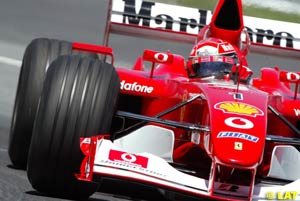
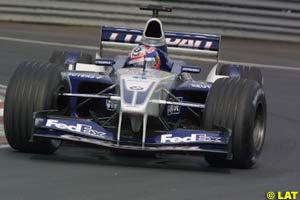
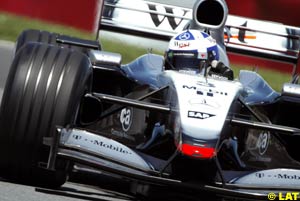
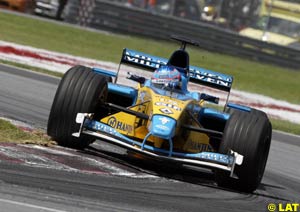
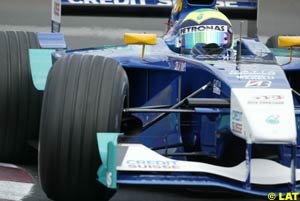
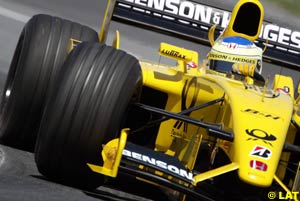
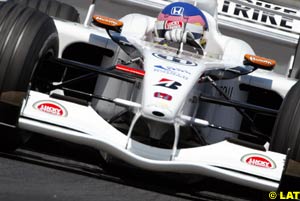
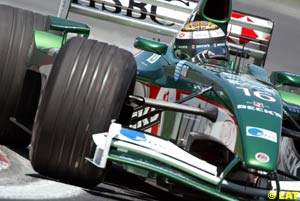
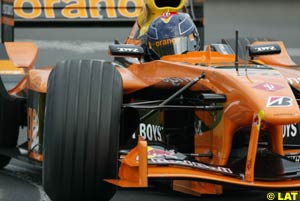
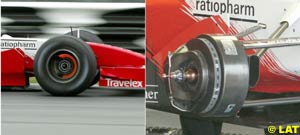
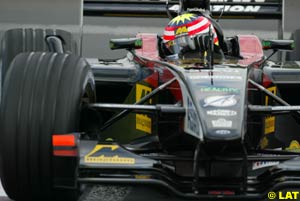
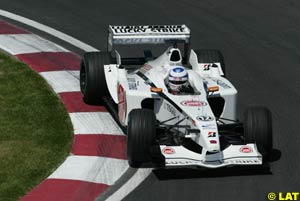 BAR finally debuted their long awaited aerodynamic step in Canada. The design is the work of Geoff Willis, the ex-Williams aerodynamicist, and the main areas worked on were aerodynamic efficiency, gearbox/clutch and rear suspension.
BAR finally debuted their long awaited aerodynamic step in Canada. The design is the work of Geoff Willis, the ex-Williams aerodynamicist, and the main areas worked on were aerodynamic efficiency, gearbox/clutch and rear suspension.
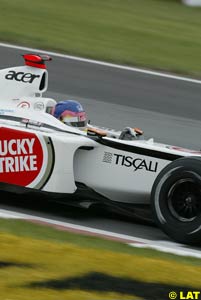 It is commonly said that a part from one car will not work as well if it was fitted to another car. However, Willis managed to improve the BAR by installing Williams type solutions around the original BAR design. All that remains is the shape of the chassis and the front of the sidepods, whose shape is dependant on the internal crash structures and would take too much time to change and would then have to be resubmitted for crash tests.
It is commonly said that a part from one car will not work as well if it was fitted to another car. However, Willis managed to improve the BAR by installing Williams type solutions around the original BAR design. All that remains is the shape of the chassis and the front of the sidepods, whose shape is dependant on the internal crash structures and would take too much time to change and would then have to be resubmitted for crash tests.
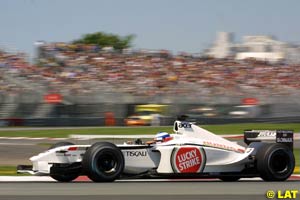 The shape of the sidepods from the start of the coke bottle shape backwards has been changed - the top surface sweep down lower to improve flow to the rear wing, and the exhausts once more finish with the engine cover, suggesting the change to the extended exhausts used since the start of the season was for aerodynamic reasons and not a requirement for the Honda engine.
The shape of the sidepods from the start of the coke bottle shape backwards has been changed - the top surface sweep down lower to improve flow to the rear wing, and the exhausts once more finish with the engine cover, suggesting the change to the extended exhausts used since the start of the season was for aerodynamic reasons and not a requirement for the Honda engine.
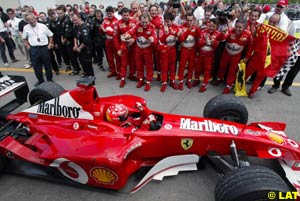 The jagged edge along the Bargeboards and small fin mounted behind them are also retained for this race. In the picture is it possible to see how much Ferrari have strived to slim the rear of the car down.
The jagged edge along the Bargeboards and small fin mounted behind them are also retained for this race. In the picture is it possible to see how much Ferrari have strived to slim the rear of the car down.
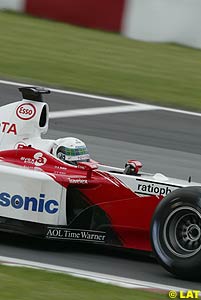 Having never run at this circuit, the team found that their simulations and base line set-up were not right for the track. Time was spent on Friday changing fundamentals like springs and gear rations, and precious time was also lost when Allan McNish had an oil leak. These problems and bad timing between the oil spills and rain of qualifying lead to the poor result of eighteenth and twentieth.
Having never run at this circuit, the team found that their simulations and base line set-up were not right for the track. Time was spent on Friday changing fundamentals like springs and gear rations, and precious time was also lost when Allan McNish had an oil leak. These problems and bad timing between the oil spills and rain of qualifying lead to the poor result of eighteenth and twentieth.
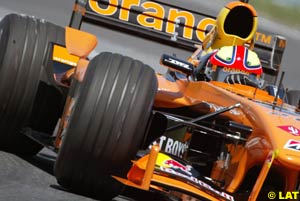 The race weekend went moderately well. Small amounts of time were lost on Friday and Saturday with set-up changes and technical problems, and the team struggled to get the results in qualifying and were left well down the grid.
The race weekend went moderately well. Small amounts of time were lost on Friday and Saturday with set-up changes and technical problems, and the team struggled to get the results in qualifying and were left well down the grid.
Please Contact Us for permission to republish this or any other material from Atlas F1.
|
Volume 8, Issue 24
Atlas F1 Exclusive
Exclusive Interview with Frentzen
Ann Bradshaw: View from the Paddock
Canadian GP Review
2002 Canadian GP Review
Canadian GP - Technical Review
Conservative Does It
Stats Center
Qualifying Differentials
SuperStats
Charts Center
Columns
Season Strokes
Elsewhere in Racing
The Grapevine
> Homepage |